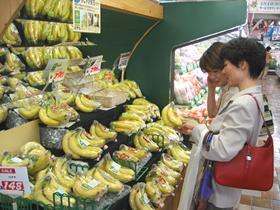
Developing fruit varieties with higher sugar levels could be the key to invigorating sales of various product categories in Japan, where overall fresh fruit consumption rates have been undergoing a seemingly inexorable fall over the past 15 years.
Japan’s household consumption on fresh fruits continued its long-term decline in 2013, slumping to a 12-year low of 82.02 kg, according to figures recently released by the Ministry of Internal Affairs and Communications Statistics Bureau.
Household expenditure was the second lowest in 12 years, at ¥34,322 (US$335.30), while the price per kg was the second highest, at ¥418 (US$4).
Junichi Moriya, president of major importer and wholesaler Tokyo Seika Trading, said a “multitude of reasons” are behind the dwindling consumption rates, including: demand and price elasticity, which are influenced by price; the challenging economic situation; a declining population, dietary changes and the differing demands of the younger generations.
Assessing consumption habits, Moriya told Asiafruit it's clear that Japanese consumers have developed a sweeter tooth when it comes to buying fruit, however.
“One of the remarkable trends is that Japanese consumers are looking for fruits with higher sugar content, even when it comes to a product like tomatoes,” said Moriya. “Recently, some of the Japanese tomato varieties have become as sweet as cherries.”
Moriya noted a clear link between the breeding of higher brix varieties of fruits and increased consumption of these items in Japan. “With the development of Gold pineapples, Gold kiwifruit and Highland bananas, we’ve seen that consumption of those fruits has grown even in a situation where fruit consumption is generally declining,” he said.
He added that higher brix varieties of domestically-grown fruits such as table grapes, apples and peaches are now being bred and developed to respond to the demand for sweeter fruit.
Japan’s younger generation in particular displays a clear preference for sweeter fruit, and a disliking for products with a sharper taste profile, such as grapefruit, Moriya added.
Japan’s grapefruit consumption in 2013 hit its lowest level in 12 years, with the average household spending ¥447 (US$4.37) on the fruit and consuming just 1.75kg.
A sharp drop in banana consumption, which hit its lowest level in the last six years, was also a key factor in the decline in overall fresh fruit consumption. Household banana consumption averaged 18.25kg in 2013 with an expenditure of ¥4,160 ($40.60), while prices averaged ¥223 (US$2.17) per kg. The lower banana consumption can largely be attributed to the impact of Typhoon Bopha, which scaled back production from Japan’s key supply source, the Philippines.
On a brighter note, kiwifruit consumption reached its highest level in nine years, at 1.58kg per household, while expenditure reached its second highest level in nine years, at ¥1,169 (US$11.42) per household.



